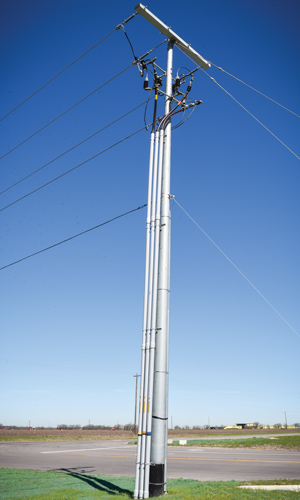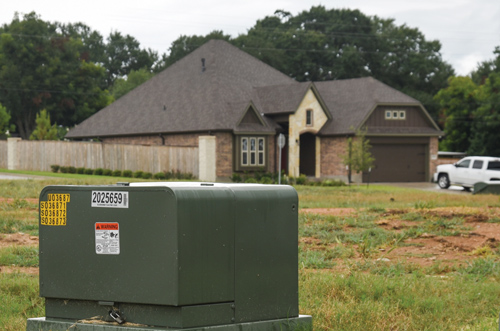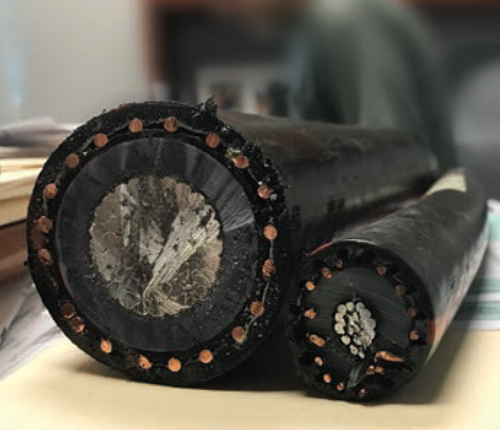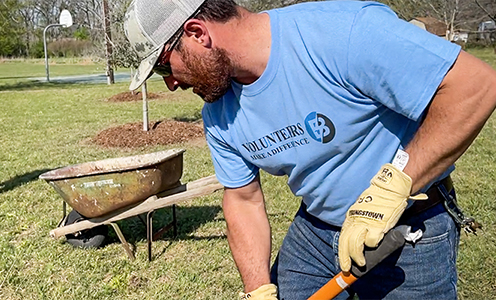Linemen working on buried lines learn how to locate the spot where a line fault has occurred and restore power. (Sarah Beal photo)
By Ed Crowell
Sarah Beal photos

PRIMARY RISER: Also called a ‘riser pole,’ this is where overhead lines go underground, protected by PVC conduits. Bluebonnet typically uses one power-carrying cable per conduit. A ‘terminator’ at the top of the pole is where an overhead line is spliced to the line heading underground. A silicon seal helps protect the splice from dust, moisture or lightning damage.
Going underground is going forward all over the Bluebonnet Electric Cooperative service area. Subterranean power is popular because it is more reliable and less intrusive on the landscape. It is more expensive than traditional overhead power lines strung between tall poles in yards and along roadways, but the price has fallen in the past decade.
It’s not just neighborhoods that are sinking their power below ground. New schools and large commercial projects favor buried lines to carry their large electrical loads.
About 500 miles of Bluebonnet’s 11,000 miles of lines disappear into the earth. Last year about 43 miles of underground lines were added to the co-op’s system and the previous year about 25 miles were added.
Just east of Austin in Manor, the subdivisions of Presidential Glen, Presidential Meadows and Stonewater have underground power lines along streets that are completed or under construction. It’s the same with Easton Park homes along McKinney Falls Parkway in southeastern Travis County and Pecan Park homes in Bastrop.
An even bigger development where power lines will be buried is the community of Whisper Valley to be built near Manor off the Texas 130 toll road. Whisper Valley model homes are expected to be open early this month. It’s a massive development billed as a “green” community. The development plans to have 7,500 homes — all served by buried electrical lines — when finished in several years.
PULLBOX: The length of any stretch of line is limited, because friction between cable and conduit can damage the line, especially when there are twists and turns and elevation changes. A 4-foot-by-4-foot green, fiberglass sectionalizer cabinet, called a ‘pullbox,’ is where power lines end and begin. They are joined electrically so power flows smoothly or can easily be turned off when needed. All of this makes it easier to find faults and reduce the size and duration of outages.

“Most every week we are either trenching for (underground distribution) cable lines or pulling lines through to make connections,” said Shawn Ely, electric distribution design supervisor at Bluebonnet.
The primary advantage of underground lines is “less electrical exposure to rain, wind, ice and lightning, which increases reliability,” Ely said. The insulated cables and watertight connections are necessary to withstand moisture, but floods could cause power outages if the buried equipment is submerged in water for too long.
One common threat to buried lines is accidental damage caused by homeowners or contractors who dig nearby and inadvertently hit electric lines, which typically are nestled 4 feet below ground. Buried lines “are not visible and therefore are more susceptible to (such) dig-ins,” Ely said.
The expense of materials, equipment and labor for underground lines has dropped in recent years. A decade ago, buried projects could cost up to 10 times more than overhead lines. Now, on average, buried electric lines in subdivisions cost anywhere from three to eight times more than a comparable system of overhead lines and poles, Ely said.

Bluebonnet workers generally begin installing underground power lines when a development’s builder installs water lines and storm-water and sewage drainage pipes. The electrical line work is done before streets are paved so Bluebonnet’s lines can cross under the roads where needed.
Instead of using pole-setting trucks and aerial bucket trucks, Bluebonnet and contractor crews dig trenches for underground lines with backhoes and trenching machines. They also use directional boring rigs and cable-pulling machines.

TRANSFORMER: Transformers are mounted on a fiberglass pad and housed in green steel boxes. Inside, voltage is decreased to 240 volts or 120 volts, the level of power used by homes and businesses. Each transformer box can serve up to six secondary junction boxes.
All linemen for Bluebonnet are trained in varying degrees of expertise with underground lines along with the regular education they receive to operate and maintain overhead power lines. The training on buried lines includes how to locate the spot where an underground line fault has occurred and how to fix the interrupted electric service.
To visitors of completed housing developments where underground lines are in place, the clean and uncluttered look of the streets is particularly obvious driving in from highways filled with utility poles, guy-wires and multiple strands of overhead line. That is the case at Shadow Glen in Manor off busy U.S. 290.

SECONDARY JUNCTION BOX: Also known as an ‘underground junction box’ or UJB for short, this is the connection point where cables extend directly to no more than two homes.
The skyline difference is definitely noticeable, said resident George Stemen, who was walking his dog on a sidewalk near the subdivision’s large recreation center and pool.
“Oh yeah,” he answered when asked if he was aware of the underground lines when he bought a house in the subdivision in 2013. “It was the same way in San Angelo where I was living before. I think it is an obvious advantage,” he said.
“The only tradeoff is the green boxes,” he said of the Bluebonnet transformers that are tucked into 4-by-4-foot locked steel boxes near the street. Each distribution box serves four to six houses.
The skinny foot-high green box in front of each house is the junction box that connects the incoming power to the line running to the house.
All the boxes, which are locked for safety, are necessary for electrical service and repair.

(Joe Stafford photo)DISTRIBUTION CABLES: These thick cables, left, carry power using a conductive aluminum center. It is protected and strengthened by layers of other materials, including water-blocking substances and sunlight-resistant polyethylene.
Stemen pointed to a cupola on top of Shadow Glen’s tall water slide structure beside the pool. “They had to rebuild that after it was hit by lightning,” he said. “One nice thing about buried lines is that the power doesn’t usually go out during storms.”
Lake Somerville State Park officials would agree. The Burleson County park, which is served by Bluebonnet, was closed because of flooding over Memorial Day weekend in 2015, when the lake rose 17 feet above its full level. Weeks of heavy rains put many of the park’s campsites — including those with electrical outlets — under water.
A Bluebonnet crew conducted an inspection before re-energizing the park’s underground cables to the campsites. Then the cables and other equipment were checked to make sure they were functioning and safe, Ely said.
STAY SAFE AROUND THOSE GREEN BOXES
Those green metal boxes may look interesting, especially to kids, but they are potentially dangerous if tampered with. Inside them is high-voltage equipment. Here are some safety tips:
- Do not obstruct the tops or sides of the large transformer boxes or the smaller junction boxes. Trees, shrubs, fencing, decks or decorations such as planters should be kept at least 5 feet from the sides and back of the boxes and 10 feet from the front. Nothing should be placed on top of the boxes and they should not be painted.
- Children should not play or sit on the boxes.
- If a box is opened, damaged or defaced, please contact a Bluebonnet member service representative at 800-842-7708 immediately.
- The boxes are locked and can only be opened by Bluebonnet employees or authorized contractors to make repairs or restore power.





